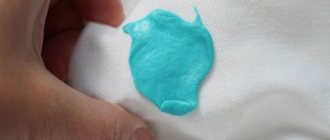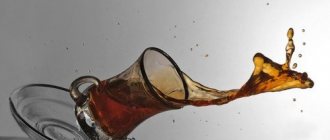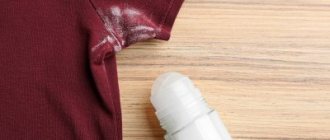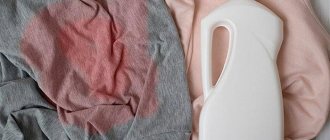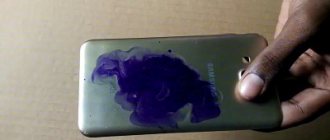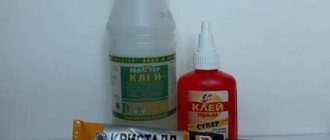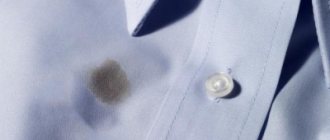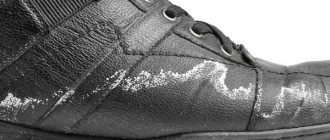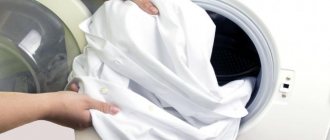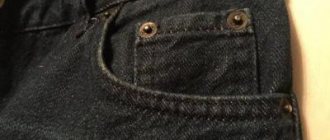How to remove using folk remedies?
There are folk remedies that can be called universal. With their help you can get rid of any types of stains. The compounds are safe for most materials if used correctly:
Hydrogen peroxide .
This cheap product works great on animal stains. Peroxide quickly removes traces of sweat, blood, fat and more. The substance has a bleaching effect, so it should be used with caution when treating dyed fabrics.- Soda. It is used both dry and diluted. Powder is sprinkled on greasy stains, and soda paste is applied to almost any stain. You can also soak the entire item in the solution.
- Vinegar. To combat various types of stains, 9% acid is used. It can be dangerous to use more concentrated solutions on fabric.
- Ammonia . It is used both as a single agent and in combination with other substances.
Two most important rules
Before you wash stubborn stains, you need to pay attention to several important nuances. Firstly, no product is universal, that is, it is impossible, for example, to remove stains on silk and burlap using the same chemical. Secondly, it is necessary to establish the nature of the pollution in order to choose the optimal method to combat it.
What does this look like in practice?
Features of the material
It is imperative to understand what material you are dealing with and understand the composition of the fibers.
All this information should be indicated on the label; there are also tips on washing (hand/machine; maximum permissible temperature) and care (is ironing allowed, is it permissible to use bleaches). The most difficult thing to deal with is traces of old dirt on such delicate and “complex” materials as silk, velvet, gauze, chiffon, jacquard, nylon, viscose, etc. They absolutely do not tolerate chlorine bleaches, hot water and intensive washing. They also ambiguously apply to some folk remedies for removing stains.
How do you know that the product you choose (homemade or store-bought) will not harm the fabric? Before soaking the entire item in it, you should test it on an inconspicuous area (inner seam) and wait for the fabric to react. If the material does not deform and the color does not change, then it can be used.
In addition, it is also important that colored or white clothes need to be cleaned. For example, hydrogen peroxide is great for white clothes, but this chemical compound can ruin a bright dress. And on the contrary, some products work well in the case of colored clothes, but snow-white linen turns yellow or darkens.
Origin of pollution
Another point to consider when dealing with stains is the nature of the stain. The problem will be solved if the stain remover can enter into a chemical reaction with dirty marks. For example, fuel oil is removed from clothing using purified gasoline, and blood is removed using ammonia.
But let's find out what types of pollution are considered difficult to remove. This group includes traces from:
- blood;
- green grass;
- sweat discharge (especially if the item is not washed immediately);
- paints;
- fuel oil (bitumen, machine oil);
- some food products;
- ink;
- brilliant green, methylene blue;
- rust.
Old and complex food stains are conventionally divided into several subgroups. And each of them will have to be fought using special means.
Photo: https://pixabay.com/photos/red-wine-spill-spot-glass-red-505296/
What products leave stubborn stains on clothes? This:
- fat and oils;
- coffee;
- red wine;
- some fruits and vegetables (blueberries, currants, beets, etc.);
- jam and jam from some fruits;
- ketchup;
- tomato paste;
- juices from dark berries and fruits.
In addition, the “age” of the contamination is also important. The faster you start fighting stains, the easier it will be to get rid of them. And vice versa: old traces of almost any origin are much more difficult to remove. You will have to resort to aggressive means, and this increases the risk of ruining the item.
How to remove with household chemicals?
You can get rid of stains on fabric using household chemicals. Available compositions:
- laundry soap - for the best effect, grate it, dilute it with water, and then apply it to the stain in the form of a paste;
- dishwashing liquid - it can be used to treat almost any stain; it is especially effective if the stains are fresh;
- Washing powder is the No. 1 remedy in the fight against various stains.
In addition to classic household chemicals, stain removers are used to remove stains from fabrics. Top 3 best lineups:
Bagi
Universal stain remover for 100 types of stains. The product is available in the form of a spray. The average cost is 350 rubles per package. Read reviews here, here and here.
BioMio
Universal stain remover . The liquid is used to treat stubborn stains; it is suitable for children's clothes and products of different colors. Price – 170 rubles. Read reviews here, here and here.
Vanish Gold Oxi Action
Universal stain remover. The product does not contain chlorine or other aggressive components and is suitable for combating complex stains. Price - from 320 rubles. Read reviews here, here and here.
Problems with the washing machine
A number of problems with the washing machine can cause stains to appear on clothes.
Oil seal problem
If the washing machine stains the laundry and oil stains appear on it, this indicates damaged seals. During operation, they are deformed, water penetrates the seat with the bearing and washes away the lubricant. The latter spoils things, and the bearings become deformed due to increased friction. This problem should be solved urgently, otherwise it will lead to damage to the washing machine. Replacing bearings and seals is a complex and time-consuming process that should be entrusted to professionals.
Foreign mechanical objects in the tank
During washing, various metal objects sometimes penetrate into the drum, and from it into the tank of the washing machine. These could be coins, bobby pins, nails, etc. They remain at the bottom of the tank, become covered with a layer of rust and pollute the water. After washing in such a liquid, rusty, yellow or brown spots appear on the laundry. Extraneous noise during operation of the washing machine also indicates the presence of a foreign object. To fix the problem, you need to remove the extra item from the tank.
The nuances of cleaning textiles of various colors
The choice of product for treating fabric depends on its color. Recommendations to pay attention to:
- White matter can be cleaned with aggressive compounds. She is not afraid of contact with acetone, solvent, vinegar and alcohol. Such items are soaked in bleach for as long as possible, but try to avoid using fat-based products, such as kerosene, vegetable oil or gasoline. After applying them, noticeable yellow spots will remain on the white item.
- Black fabric needs careful cleaning. To remove stains from it, gentle products are used. It is best to use substances that help fix the color: alcohol, vinegar, saline solution. Black items should be washed and soaked in cool water for a short period of time.
- Colored matter also does not tolerate contact with aggressive substances. Their choice largely depends on the strength of the dye. The weaker its adhesion to the surface, the lower the concentration of the cleaning agent should be. Such products are washed in warm, but not hot water. The average soaking time is 1 hour.
Remove red, pink
Everyone has had a bad experience in their life that could leave red or pink stains from vomit on their clothes.
Information. It is difficult to deal with such stains if they have already dried, but even in this case the task is quite doable.
List of steps to remove stains:
- The first step is to scrape off all solid particles from the surface;
- After this, the stain should be rinsed in warm water. If you started the procedure on time, then at this stage the stain can already be eliminated, but if not, we move on;
- The damaged item should be soaked in a basin of warm water and left there for several hours, preferably overnight;
- If the stain does not come off after the previous step, be patient, as well as soda and lemons;
- The stain must be thoroughly sprinkled with baking soda so that the powder completely covers the damaged area;
- Pour some vinegar or lemon juice onto the affected area. After this step, the baking soda will react with the acid and begin to fizz. Scrub the stain a little with an old toothbrush or abrasive sponge, then remove the juice and baking soda mixture from the surface of the clothing;
- Apply a little dishwashing detergent to the stain and soak again in a bowl of warm water for several hours;
- Wash the item as usual.
Attention! If after these procedures the stain does not come off, you will have to resort to using commercial stain removers or dry cleaning services.
Helpful information
Tips to follow when removing stains from fabric:
The fight against old stains should not be put off until later; treatment begins immediately after contamination is detected, so it can be dealt with without the use of aggressive compounds;- stains should be removed from the edge to the center so as not to stain the clean area;
- For processing, use only white material: napkins or cotton pads, so when in contact with chemicals, the pigment from the colored rag can transfer to the surface being cleaned;
- Before you begin processing, you need to study the information indicated on the product label; different fabrics have their own care rules.
General rules for rust removal
There are different methods for removing rust stains and stains from white and light-colored clothing. For this purpose, you can use: 1. Various acids. 2. Detergents. 3. Special stain removers. 4. Professional dry cleaning. The decision about which method is best to use must be made taking into account the quality of the fabric. Products made from genuine leather, suede, velor and wool should not be soaked. These same materials are resistant to acid treatment. Some synthetic fabrics also do not tolerate acidic compounds. But cotton, linen and denim are great for soaking and washing. You can use bleaches and stain removers on these fabrics. To be sure of success and not completely ruin the item, it is better to first test the product on an inconspicuous area of the clothing (for example, in the area of the seams on the wrong side).
Machine washable
The gentle mode in an automatic machine is recommended not only for items made of silk and cashmere. Frequent intensive washing leads to damage to the fibers and leaves pellets and abrasions on the surface of the fabric. Light-colored linen turns yellow and acquires a gray tint. Knitwear suffers especially badly.
Before loading things into the machine:
- determine color groups of products;
- fold laundry according to degree of soiling and type of fabric;
- do not wash cotton, synthetics, and sports items on the same cycle;
- “Intensive” washing is used only when necessary.
Handwash
When washing by hand, the fabric is damaged less, but there is a risk of getting a damaged item.
- Avoid hot water. Fabric made from cotton, linen, or mixed fiber will shrink, knitwear will lose its shape and become loose, bright colors will fade, and viscose will lose its shine.
- Do not rub dirt too vigorously.
- Bleaches, solvents, and stain removers are used locally, first testing on the inside of the product.
- You cannot twist things, squeeze them carefully, roll them up, or squeeze them slightly.
- Do not dry vertically if the fabric is soaked in water. The moisture should drain.
What not to do and why
How to remove wax from clothes quickly and without unpleasant consequences:
- Do not rub the liquid drop, because this will only increase the area of contamination. It is better to let the paraffin harden, then remove it using a suitable method.
- Sharp knives will damage the fabric, so the frozen mass is cleaned off with a plastic scraper.
- Colored paraffin cannot be removed using hot methods. The stain will grow and the dye will permanently stain the fabric.
- Items can only be put into an electric dryer after the contamination has been completely removed. Otherwise, it will become much more difficult to remove the stain later.
- Stain removers and solvents must be tested before use. To do this, you need to apply a couple of drops to an inconspicuous area and wait a little. If the material does not lose color and does not change its structure, then the drug can be used.
You can remove wax from clothes using a special product or a folk method. How to wash wax should be chosen depending on the type of material.
